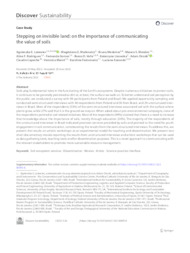Stepping on invisible land: on the importance of communicating the value of soils.
Stepping on invisible land: on the importance of communicating the value of soils.
Autoria: LATAWIEC, A. E.; MARKOWICZ, M. E.; MEDEIROS, B.; MENDES, M. S.; RODRIGUES, A. F.; GOMES, F.; VALLE, B. D.; LISOWSKA, K.; DROSIK, A.; CAPECHE, C. L.; MAIOLI, V.; FEDOROWICZ, K.; AZEVEDO, L.
Resumo: Soils play fundamental roles in the functioning of the Earth's ecosystems. Despite numerous initiatives to protect soils, it continues to be generally perceived as dirt or, at best, the surface we walk on. To better understand soil perception by the public, we conducted a survey with 99 participants from Poland and Brazil. We applied opportunity sampling and conducted semi-structured interviews with 40 respondents from Poland and 30 from Brazil, and 29 unstructured interviews in Brazil. Most of the respondents (53%) of the semi-structured interviews associated soil with the surface where plants grow, while 27% said that it is the ground we step on. When asked about pro-environmental campaigns, none of the respondents pointed to soil-related initiatives. Most of the respondents (99%) claimed that there is a need to increase their knowledge about the importance of soils, mostly through education (30%). The majority of the respondents of the unstructured interviews in Brazil indicated provision services provided by soils and pointed to the need for youth engagement in soil communication, corroborating the results from the semi-structured interviews. To address this, we present the results on artistic workshops as an experimental model for teaching and dissemination. We present two short documentary movies reporting the results from unstructured interviews and artistic workshops that can be used as data gathering tools, teaching tools and for dissemination purposes. This is a novel approach to communicating with the relevant stakeholders to promote more sustainable resource management.
Ano de publicação: 2022
Tipo de publicação: Artigo de periódico
Unidade: Embrapa Solos
Observações
1 - Por padrão são exibidas publicações dos últimos 20 anos. Para encontrar publicações mais antigas, configure o filtro ano de publicação, colocando o ano a partir do qual você deseja encontrar publicações. O filtro está na coluna da esquerda na busca acima.
2 - Para ler algumas publicações da Embrapa (apenas as que estão em formato ePub), é necessário ter, no celular ou computador, um desses softwares gratuitos. Sistemas Android: Google Play Livros; IOS: iBooks; Windows e Linux: software Calibre.
Acesse outras publicações
Acesse a Base de Dados da Pesquisa Agropecuária (BDPA) para consultar o acervo completo das bibliotecas da Embrapa.

